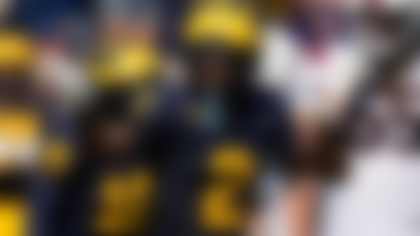But a cautious Mario Williams warned his teammates that there would be a wrinkle. He was right. The wrinkle creased Houston's defense for a 53-yard touchdown, on a pass from Chad Pennington to Patrick Cobbs. Neither Pennington nor Cobbs had played much of a role in Wildcat in the Dolphins' previous two games. This was a twist the Texans didn't see coming.
Anatomy of a Play
Anatomy of a Play extras:
»
Statistical analysis of 'Wildcat'
»
How Dolphins set up score
»
Cobbs explains how he got so open
Previously:
»
'Wildcat' beats Patriots
More Anatomy of a Play:
»
Schaub's game-winning sneak
Here's a quick recap of Wildcat:
The personnel is five linemen, three backs, two tight ends and quarterback Chad Pennington. Pennington aligns as a wide receiver -- in this case, he was the outside receiver to the right. Running back Ronnie Brown takes a shotgun snap at quarterback. Running back Ricky Williams quickly motions from left to right, running in front of Brown just after the ball is snapped, in order to either fake or take a handoff. The offensive line is "unbalanced," with left tackle Jake Long moving over to the right side in a tight end position and tight end Anthony Fasano moving over to the left side in a tackle position. Cobbs aligns as a wide receiver. On the touchdown, he was in a slot position to the right, inside of Chad Pennington.
Cobbs' touchdown was the Dolphins' fifth offensive play, 2nd and 8 from their own 47-yard line. On the preceding play, Miami had run their first Wildcat formation of the game, and the result was a 2-yard run by Ricky Williams. The Dolphins called that play to see how Houston would square off against Wildcat -- with man-to-man or zone coverage. The Texans' choice of man-to-man dictated the next playcall.
On the touchdown, the Dolphins got the matchup they wanted when 227-pound safety Brandon Harrison, an inexperienced and instinctive run-stuffing safety, lined up in man coverage on Cobbs. Miami knew the second year player from Stanford would attack the line of scrimmage if a handoff went to Williams, and why wouldn't he? On film, that's what the Dolphins had shown. Based on Harrison's tendency to play downhill and the Dolphins tendency to run out of Wildcat, the bait was set for Harrison.
As the handoff went to Williams, Cobbs moved toward Harrison with the speed of a blocker, not a route runner, and Harrison's instincts took over. He braced himself for contact, preparing to shed Cobbs' block and tackle Williams. But just when Cobbs got close enough to reach out and block Harrison, Cobbs exploded with a burst of speed past him, leaving Harrison standing confused as to what he was seeing.
By the time Williams pitched the ball back to Pennington, it was too late. Cobbs was 30 yards behind everyone and all Harrison could do was hope for a dropped pass. The touchdown was a great example of a team utilizing knowledge of its own tendencies, as well as the tendencies of an opponent, and exploiting them to gain an advantage.



